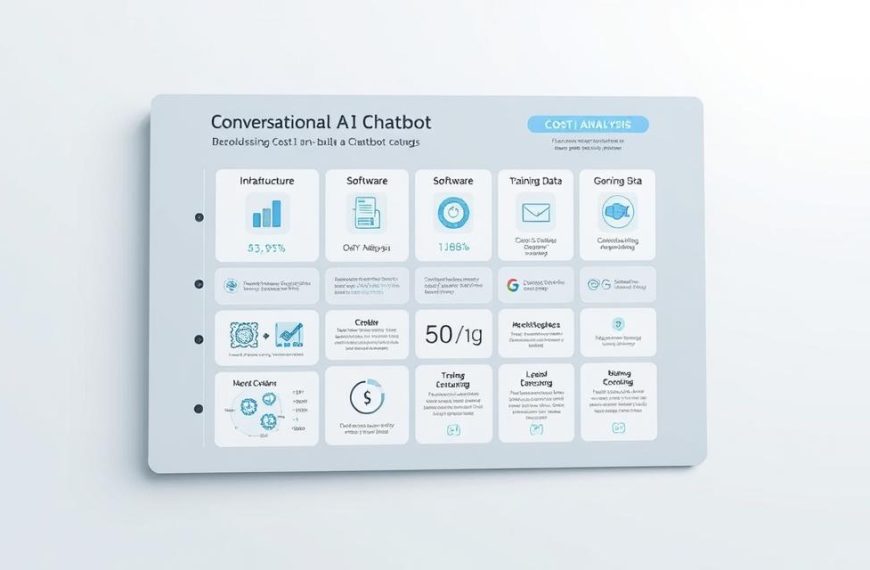Conversational AI has revolutionised customer engagement, with chatbot adoption growing rapidly across industries. This comprehensive guide offers a structured approach for newcomers to navigate the complex world of automated dialogue systems.
Effective planning forms the bedrock of any successful implementation. Identifying your target audience and defining precise objectives ensures your solution aligns with real user needs. Whether creating a simple FAQ assistant or handling intricate queries, clarity in purpose drives meaningful interactions.
The current landscape offers diverse approaches, from basic rule-based systems to sophisticated machine learning models. Choosing between these depends on your technical capacity and desired complexity. Modern frameworks enable both code-free solutions for beginners and customisable options for developers.
User experience remains paramount in conversational design. Natural dialogue flows and contextual awareness transform functional exchanges into engaging conversations. Regular testing and iterative improvements help maintain relevance as audience expectations evolve.
This roadmap addresses common challenges, from deployment strategies to ongoing optimisation. By understanding these fundamentals, you’ll gain the confidence to create solutions that deliver genuine value through every interaction.
Getting Started with Chatbots
Successful automated dialogue systems begin with strategic planning. Clarifying your bot’s purpose ensures it meets audience needs while aligning with business goals. Start by asking: Will this tool resolve common queries, generate leads, or provide personalised recommendations?
Defining Chatbot Objectives
Establishing precise targets shapes your project’s direction. Analyse your audience’s preferred communication styles and frequent concerns. For example, a retail bot might prioritise product suggestions, while a banking assistant focuses on transaction support.
An Overview of Chatbot Technology
Modern solutions range from basic decision-tree architectures to AI-driven platforms. Rule-based systems excel at handling predictable scenarios, while machine learning models interpret nuanced language. Key components include:
- Natural language processing for understanding slang and intent
- Integration capabilities with platforms like WhatsApp
- Analytics dashboards tracking engagement metrics
Deployment options vary from website widgets to mobile apps. Many UK businesses combine pre-built frameworks with custom features for optimal results. Regular updates based on user feedback maintain relevance as needs evolve.
Essential Concepts and Terminology
Building intelligent conversational systems requires mastering core technical elements and design principles. This section clarifies foundational language models and interaction patterns that shape modern solutions.
Understanding Language Models
Modern systems rely on algorithms trained to process human language. These models analyse patterns in text and speech to interpret intent. Key types include:
- Transformer-based models for contextual understanding
- Recurrent neural networks handling sequential data
- Rule-based systems managing predictable scenarios
Advanced versions extract entities like dates or locations from user input. They generate responses mirroring natural conversation through vast training datasets.
Exploring User Experience and Interactions
Effective design balances functionality with engagement. Three primary interaction methods dominate:
- Menu-driven interfaces for structured choices
- Free-text fields allowing natural queries
- Hybrid approaches combining both styles
Successful implementations maintain context across exchanges and handle errors gracefully. Techniques like persona development ensure interactions feel coherent and purposeful.
how to develop chatbot
Creating responsive conversational interfaces demands a methodical approach. This structured pathway balances technical precision with user-centric design, ensuring solutions address real-world needs while remaining adaptable.
Step-by-Step Development Process
Initiate your project by mapping core objectives and interaction scenarios. Define primary use cases through stakeholder workshops, then draft conversation flows that reflect natural dialogue patterns. This groundwork prevents scope creep and establishes measurable success criteria.
Select frameworks matching your team’s expertise and system requirements. Popular options in the UK market include Rasa for custom solutions and Botpress for low-code environments. Configure version control systems early to track iterations efficiently.
Training data quality directly impacts performance. Source authentic queries from customer service logs, then categorise them into intents like “booking enquiries” or “payment issues”. Augment this foundation with synthetic examples to cover edge cases.
Prototype testing reveals usability gaps before full deployment. Conduct A/B trials comparing menu-driven versus free-text interfaces, refining tone and response logic based on participant feedback. This iterative cycle continues until satisfaction benchmarks are met.
Implement features progressively, starting with basic intent matching. Gradually introduce context tracking using session storage, ensuring smooth transitions between conversation topics. Document each milestone thoroughly for team alignment and future scaling.
Implementing Conversational Memory and Message History
Maintaining context across interactions separates functional tools from truly intelligent assistants. Effective conversation history management allows systems to reference prior exchanges, creating seamless dialogues that mirror human communication.
Strategies for Data Persistence
LangGraph’s architecture simplifies data storage with adaptable solutions. Developers can start with the MemorySaver module for testing, which retains messages temporarily during sessions. For production environments, SQLite or PostgreSQL integrations offer permanent storage with encryption capabilities.
| Persistence Strategy | Use Case | Scalability |
|---|---|---|
| In-Memory Storage | Prototyping | Single session |
| SQLite Database | Small-scale apps | Moderate concurrency |
| PostgreSQL | Enterprise solutions | High traffic |
Configuring Memory in Chat Applications
Unique thread identifiers enable simultaneous conversation tracking. Initialise configurations with:
config = {"configurable": {"thread_id": "abc123"}} This approach lets one app manage multiple user threads independently. Historical interactions inform response logic while protecting privacy through isolated history records.
Optimisation techniques include automatic data pruning for older entries and compression for lengthy exchanges. Regular audits ensure compliance with UK data protection regulations whilst maintaining performance standards.
Utilising Prompt Templates for Customisation
Custom response generation transforms rigid query handlers into adaptable conversational partners. Prompt templates act as blueprints, shaping how language models interpret and respond to user inputs. These structured frameworks maintain consistency while allowing personality adjustments across different scenarios.
Crafting Effective System Messages
Foundational system messages define your assistant’s role and boundaries. Use ChatPromptTemplate to establish:
- Professional tone guidelines
- Response length constraints
- Fallback protocols for unclear queries
The Teams AI library’s {{ $user.name }} syntax personalises interactions by accessing stored profile data. For banking solutions, templates might reference transaction history using {{ $conversation.last_payment }}.
| Template Type | Primary Function | Syntax Example |
|---|---|---|
| System Directive | Define response boundaries | “You are a travel assistant specialising in UK holidays” |
| Dynamic Input | Inject real-time data | “{{ $temp.weather_data }}” |
| Function Call | Execute external operations | “{{ getExchangeRate GBP EUR }}” |
Integrating Dynamic User Inputs
MessagesPlaceholder functionality enables context-aware dialogues. A retail template might combine product preferences with location data:
{{ $user.favourite_brand }} available near {{ $temp.postcode }} Parameterised functions fetch live information through syntax like {{ checkStockLevels "blue shirt" }}. This approach keeps responses current without manual updates.
Regular template audits ensure alignment with changing user needs. A/B testing different phrasings optimises engagement while maintaining brand voice consistency across all touchpoints.
Integrating and Testing Your Chatbot Solution
Thorough validation separates prototypes from production-ready systems. Jupyter Notebooks offer an ideal environment for iterative testing, allowing real-time adjustments when APIs malfunction or outputs diverge from expectations. This hands-on approach accelerates learning while reducing deployment risks.
Running Practical Tutorials in Jupyter Notebooks
Begin by installing essential libraries:
pip install langchain-core langgraph>0.2.27This version ensures compatibility with conversation history features. Create test cases validating intent recognition across varied phrasings. For instance, check if “reset my password” and “can’t access account” both trigger proper security protocols.
Structure your tutorial to cover three key areas:
- Basic dialogue flows using sample code
- Edge cases like ambiguous queries
- Performance metrics tracking response times
Leverage the ChatBot web interface to simulate user interactions. Monitor how your model handles consecutive questions requiring context retention. Export source code snippets for version comparison when debugging regressions.
Automated test suites prove invaluable for continuous integration pipelines. Schedule daily runs checking core functionalities, ensuring updates don’t break critical features. UK-based teams often combine pytest frameworks with monitoring tools like Sentry for comprehensive quality assurance.
Enhancing Bot Interactions and Streamlining Dialogue
Balancing technical efficiency with human-like engagement remains critical for modern conversational systems. Optimal performance requires strategic management of dialogue data and continuous refinement based on real-world usage patterns.
Trimming and Managing Conversation History
LangChain’s trim_messages helper prevents context window overload by dynamically prioritising relevant exchanges. Configure parameters to:
- Preserve system messages defining core bot behaviour
- Maintain recent user queries for contextual continuity
- Automatically discard redundant or outdated content
Set token limits based on your LLM’s capacity, typically keeping exchanges under 4,000 tokens for cost-effective operations. Partial message retention ensures critical data isn’t lost during pruning cycles.
Incorporating User Feedback and Optimising Responses
Unanswered queries reveal knowledge gaps requiring attention. Categorise unmatched questions weekly, then:
- Add new training examples for recurring themes
- Develop fallback responses for ambiguous inputs
- Update intent classifications based on emerging patterns
Analytics dashboards tracking response time and success rates highlight improvement areas. One UK retailer reduced resolution times by 37% through fortnightly feedback reviews.
“Systems ignoring user input patterns become obsolete within six months. Continuous adaptation isn’t optional – it’s survival.”
Implement A/B testing for response variations, measuring metrics like conversation completion rates. Combine quantitative data with qualitative surveys to refine tone and information depth.
Conclusion
Creating effective conversational tools combines technical precision with human-centric design. The journey from initial concept to functional assistant requires balancing robust architecture with adaptive learning capabilities. Mastery of language models and dialogue flow patterns forms the foundation, while thoughtful memory management ensures context-aware exchanges.
Regular updates keep your building chatbot efforts aligned with shifting user expectations. Analyse interaction logs to identify common queries that need refined responses. This process turns raw data into actionable insights, allowing you to train chatbot systems more effectively over time.
Successful implementations evolve through iterative testing cycles. A/B comparisons of response styles and conversation triggers reveal optimal engagement strategies. Prioritise clarity in default messages while leaving room for personality customisation based on your brand’s name and values.
The true measure of any conversational tool lies in its real-world impact. Track resolution rates and user satisfaction scores to validate improvements. With dedication to continuous enhancement, your creation will deliver meaningful experiences that stand the test of time.



















